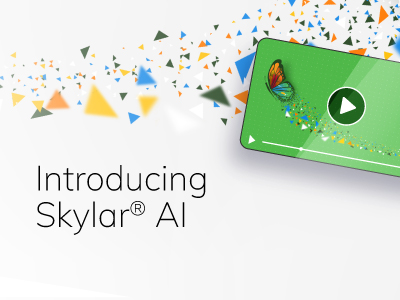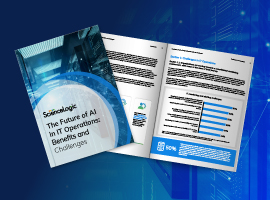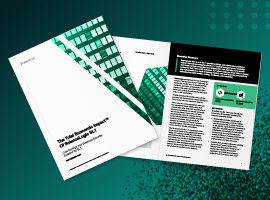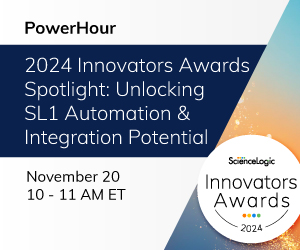- Why ScienceLogic
- Main Menu
- Why ScienceLogic
Why ScienceLogic
See why our AI Platform fuels innovation for top-tier organizations.
- Why ScienceLogic
- Customer Enablement
- Trust Center
- Technology Partners
- Pricing
- Contact Us
- Product Tours
 See ScienceLogic in actionTake a Tour
See ScienceLogic in actionTake a TourExperience the platform and use cases first-hand.
- Platform
- Main Menu
- Platform
Platform
Simplified. Modular-based. Efficient. AI-Enabled.
- Platform Modules
- Core Technologies
- Platform Overview
- Virtual Experience
 Skylar AI RoadmapRegister Today
Skylar AI RoadmapRegister TodayLearn about our game-changing AI innovations! Join this virtual experience with our CEO, Dave Link and our Chief Product Officer, Mike Nappi.
November 26
- Solutions
- Main Menu
- Solutions
Solutions
From automating workflows to reducing MTTR, there's a solution for your use case.
- By Industry
- By Use Case
- By Initiative
- Explore All Solutions
- Survey Results
 The Future of AI in IT OperationsGet the Results
The Future of AI in IT OperationsGet the ResultsWhat’s holding organizations back from implementing automation and AI in their IT operations?
- Learn
- Main Menu
- Learn
Learn
Catalyze and automate essential operations throughout the organization with these insights.
- Blog
- Community
- Resources
- Events
- Podcasts
- Platform Tours
- Customer Success Stories
- Training & Certification
- Explore All Resources
- 157% Return on Investment
 Forrester TEI ReportRead the Report
Forrester TEI ReportRead the ReportForrester examined four enterprises running large, complex IT estates to see the results of an investment in ScienceLogic’s SL1 AIOps platform.
- Company
- Main Menu
- Company
Company
We’re on a mission to make your IT team’s lives easier and your customers happier.
- About Us
- Careers
- Newsroom
- Leadership
- Contact Us
- Virtual Event
 2024 Innovators Awards SpotlightRegister Now
2024 Innovators Awards SpotlightRegister NowSave your seat for our upcoming PowerHour session on November 20th.
The Journey to Autonomic IT: Mastering the Transition to Machine-Assisted IT


By now, you should be no stranger to Autonomic IT. The full realization of AIOps, combining AI, data, and automation to deliver a self-healing and self-optimizing IT infrastructure that operates autonomously, continuously monitoring and optimizing technology investments, and freeing up IT resources for innovation is on the horizon.
In our first blog, we discussed Phase 1 of the Autonomic IT journey: Siloed IT. This phase is characterized by disparate tools, fragmented data, and isolated teams which lead to overly complex, disjointed monitoring and reactive troubleshooting. This blog also discussed the necessary steps to transition to Phase 2: Coordinated IT.
In Phase 2, silos are broken down, tools are consolidated, and data and processes are integrated into a unified framework providing visibility across the IT estate.
However, there’s still significant work ahead. In reality, most organizations aren’t as far along in their journey as they believe, with many still in Phase 1 or 2. To advance toward Autonomic IT, improve responsiveness to business and customer demands, and streamline operational processes, it’s essential to embrace automation and master the shift to machine-assisted IT.
Automation, But Not as You Know It
Although IT automation is well-established, many organizations have only automated routine ITOps tasks. These automations tend to be narrow in scope, confined to specific tools or applied to individual devices or layers of the IT stack. This fragmented approach—where data is scattered and IT operations lack integration—prevents machine learning (ML), AI, and automation from fully realizing their potential to generate insights, resolve issues, and improve efficiency. In such cases, the scattered approach hinders the development of cohesive ‘Machine-Learned Data,’ limiting the benefits advanced technologies can provide.
Here’s where the ScienceLogic AI platform and Skylar AI suite can truly make a difference.
ScienceLogic empowers you to transform your IT operational processes from human-driven and siloed to machine-driven and integrated so you can unlock new levels of efficiency and effectiveness.
Understandably, CIOs and ITOps teams may feel apprehensive about the idea of machines running IT without human oversight. Concerns about losing control, the implications of AI decision-making, and the potential for job displacement are valid and expected.
These concerns can be addressed in Phase 3 of the Autonomic IT journey. In this phase, machines don’t take over entirely; instead, they learn from human input and data to develop a situational awareness of your IT environment. This enables them to solve complex problems, make intelligent decisions, and automate routine tasks. Rather than replacing engineers, this process frees them from tedious work, allowing them to focus on innovation and strategic initiatives that drive the business forward.
Consider this shift not as “machines running IT without human oversight” but as “machines enhancing human capabilities.” It’s a phase in the journey to Autonomic IT we call “Machine-Assisted IT.”
Let’s look at the characteristics of Phase 3 and how the ScienceLogic AI platform supports them.
Making the Transition to Phase 3: Machine-Assisted IT
Machine-assisted IT builds on Phases 1 and 2 of the Autonomic IT journey with compounding benefits for your business at every step.
Organizations that have reached Phase 2 maturity are using the ScienceLogic AI platform to converge data from across the IT estate into a contextualized data lake for more meaningful analysis, coordination, and enhanced decision-making. Phase 3 takes this further by leveraging the aggregated data to create a machine-learned, automated environment.
Guided by your engineers’ actions, diagnostic data, and historical data (the “breadcrumbs” generated by operational patterns, events, and triage actions assimilated over time), the ScienceLogic AI platform continuously analyzes the data, identifies patterns and repetitive workflows, and use those insights to take automated actions or make predictions.
For example, with a rich, contextualized data lake and machine-learned insights, the platform can automate routine diagnostic and basic triage tasks at lightning strike across the IT stack. It can identify the root cause of an issue (application, database, network, container, and more), determine which services are affected, and even create a ticket to address the issue for quicker MTTR – thereby ensuring people and processes stay aligned on progress and resolution.
Machine-assisted IT capabilities that the ScienceLogic platform and Skylar AI suite enable during Phase 3 include:
- Automatic root cause analysis for 10x faster issue diagnosis.
- Automatic CMDB data population and synchronization from across multiple sources to maintain CMDB accuracy in real-time.
- Automated service notifications for comprehensive issue visibility across hybrid IT.
- Automated incident response with scripted ITSM workflows. No one likes to manually enter data into a ticketing system. When an incident occurs, the ScienceLogic platform automatically creates a ticket and enriches it with diagnostic data for a complete organizational approach to fault analysis and resolution that spans IT and empowers technicians to resolve incidents quickly the first time.
These automation actions not only streamline operations but also adapt and continuously refine to evolving business conditions, improving the accuracy of automated actions over time and empowering the business with continuous improvement across the IT stack.
Coming Soon! Advancing to Phase 4: AI-Advised IT
As your organization warms up to machine-assisted IT and automation, you can begin to incorporate advanced AI/ML and automation to identify issues and recommend and initiate remediation actions for even greater efficiencies. This phase in the Autonomic IT journey – known as AI-Advised IT – will be the topic of our next blog in this series. Stay tuned!
Learn more about the Autonomic IT journey or contact us to determine your Autonomic IT maturity.




